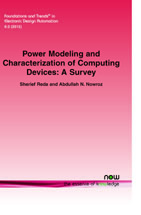Power Modeling and Characterization of Computing Devices
By Sherief Reda, Brown University, USA, sherief reda@brown.edu | Abdullah N. Nowroz, Brown University, USA, Abdullah nowroz@brown.edu
Abstract
In this survey we describe the main research directions in pre-silicon power modeling and post-silicon power characterization. We review techniques in power modeling and characterization for three computing substrates: general-purpose processors, system-on-chip-based embedded systems, and field programmable gate arrays. We describe the basic principles that govern power consumption in digital circuits, and utilize these principles to describe high-level power modeling techniques for designs of the three computing substrates. Once a computing device is fabricated, direct measurements on the actual device reveal a great wealth of information about the device's power consumption under various operating conditions. We describe characterization techniques that integrate infrared imaging with electric current measurements to generate runtime power maps. The power maps can be used to validate design-time power models and to calibrate computer-aided design tools. We also describe empirical power characterization techniques for software power analysis and for adaptive power-aware computing. Finally, we provide a number of plausible future research directions for power modeling and characterization.
Power Modeling and Characterization of Computing Devices
Power consumption has emerged as the number one challenge towards improving the performance of future computing systems. Power Modeling and Characterization of Computing Devices: A Survey provides an overview of techniques in power modeling and characterization for three computing substrates: general-purpose processors, system-on-chip-based embedded systems, and field programmable gate arrays. It describes the basic principles that govern power consumption in digital circuits, and utilizes these principles to describe high-level power modeling techniques for designs of the three computing substrates. Once a computing device is fabricated, direct measurements on the actual device reveal a great wealth of information about the device's power consumption under various operating conditions. This monograph discusses characterization techniques that integrate infrared imaging with electric current measurements to generate runtime power maps. The power maps can be used to validate design-time power models and to calibrate computer-aided design tools. The monograph also describes empirical power characterization techniques for software power analysis and for adaptive power-aware computing. It concludes by outlining four promising future research areas. Power Modeling and Characterization of Computing Devices: A Survey is an invaluable reference for anyone with an interest in power consumption and how it affects the performance of computing systems.
